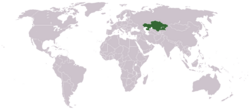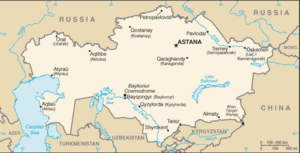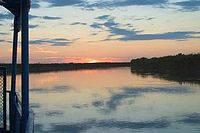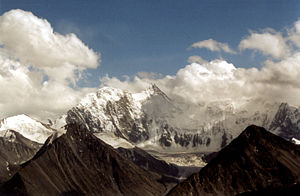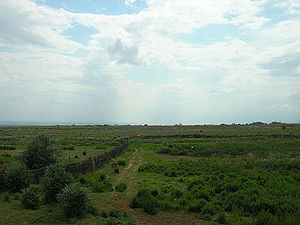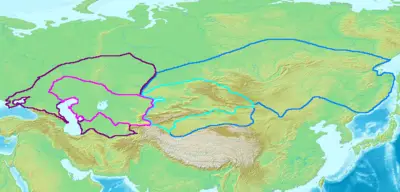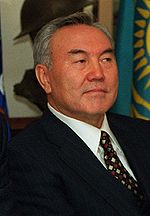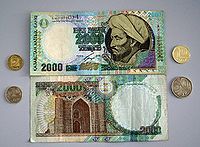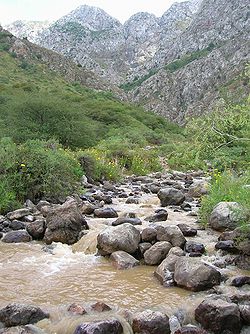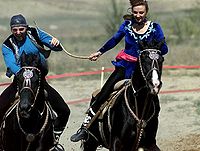Kazakhstan
| Қазақстан Республикасы Qazaqstan Respublïkası Республика Казахстан Respublika Kazakhstan Republic of Kazakhstan | |||||
| |||||
| Anthem: My Kazakhstan | |||||
| Capital | 25px Astana 51°10′N 71°30′E | ||||
|---|---|---|---|---|---|
| Largest city | Almaty | ||||
| Official languages | Kazakh (state language), Russian | ||||
| Government | Republic | ||||
| - President | Nursultan Nazarbayev | ||||
| - Prime Minister | Karim Masimov | ||||
| Independence | from the Soviet Union | ||||
| - 1st Khanate | 1361 as White Horde | ||||
| - 2nd Khanate | 1428 as Uzbek Horde | ||||
| - 3rd Khanate | 1465 as Kazakh Khanate | ||||
| - Declared | December 16, 1991 | ||||
| - Finalized | December 25, 1991 | ||||
| Area | |||||
| - Total | 2,724,900 km² (9th) 1,052,085 sq mi | ||||
| - Water (%) | 1.7 | ||||
| Population | |||||
| - January 2006 estimate | 15,217,700[1] | ||||
| - 1999 census | 14,953,100 | ||||
| - Density | 5.4/km² 14.0/sq mi | ||||
| GDP (PPP) | 2005 estimate | ||||
| - Total | $125.5 billion | ||||
| - Per capita | $8,318 | ||||
| HDI (2004) | |||||
| Currency | Tenge (KZT)
| ||||
| Internet TLD | .kz | ||||
| Calling code | +7 | ||||
Kazakhstan, officially the Republic of Kazakhstan, is a country that is bigger than Western Europe, and stretches over a vast expanse of northern and central Eurasia to the west of the Ural River.
Before independence, Kazakhstan existed as the Kazakh SSR republic in the Soviet Union. It is now a member of the Commonwealth of Independent States.
Kazakhstan is the ninth largest country in the world by area, but is ranked 62nd in population, with fewer than 15 people per square mile (six people per square kilometre).
Historians believe the vast steppes of Kazakhstan were where humans first domesticated the horse.
Kazakhstan is the site of the Baikonur Cosmodrome space launch center, leased to Russia, and has launched its first commercial satellite, KazSat 1.
The word “Kazakh” is derived from an ancient Turkic word meaning "independent, a free spirit." It reflects the Kazakh people’s nomadic horseback culture and is related to the term "cossack". The old Persian word "stan" means "land" or "place of".
Geography
Kazakhstan has borders with Russia, the People's Republic of China, and the Central Asian countries Kyrgyzstan, Uzbekistan and Turkmenistan, and has a coastline on the Caspian Sea. With an area of 1.05 million square miles (2.7 million square kilometres), Kazakhstan is the ninth-largest country in the world and the largest landlocked country in the world. It is equivalent to the size of Western Europe.
The terrain extends west to east from the Caspian Sea to the Altay Mountains and north to south from the Western Siberia plains to the oases and deserts of Central Asia. The Kazakh Steppe, with an area of around 310,600 square miles (804,500 square kilometres) occupies one-third of the country, and is the world's largest dry steppe characterized by large grassland and sandy regions. There is considerable topographical variation within Kazakstan. The highest elevation, Khan Tengri Mountain, on the Kyrgyz border in the Tian Shan range, is 23,000 feet (7010 meters). The lowest point, at Karagiye, in the Caspian Depression in the west, is 430 feet (132 meters) below sea level. Only 12.4 percent of Kazakstan is mountainous, mostly in the Altay and Tian Shan ranges of the east and northeast, although the Ural Mountains extend south from Russia. Many Altay and Tian Shan peaks are snow covered year-round, and their run-off is the source for Kazakstan's rivers and streams.
Important rivers and lakes include: the Aral Sea, Ili River, Irtysh River, Ishim River, Ural River, Lake Balkhash, and Lake Zaysan.
Because Kazakstan is so far from the oceans, the climate is continental and dry. Precipitation in the eastern mountains averages as much as 24 inches (600 millimeters) per year, mostly as snow, but most of the republic receives only four to eight inches (100 to 200 millimeters) yearly. Kazakstan is sunny. Average winter temperatures are 26.6°F (-3°C) in the north and 64.4°F (18°C) in the south. Summer temperatures average 66°F (19°C) in the north and 86°F (30°C) in the south. Within locations differences are extreme, and temperature can change suddenly. The winter air temperature can fall to -58°F (-50°C), and in summer the air temperature can reach as high as 122°F (50°C).
Fauna that can be found in the steppes includes the Saiga Antelope, Siberian Roe Deer, wolves, foxes, badgers, snow leopards, eagles, and falcons.
Natural hazards include earthquakes in the south, and mud slides around Almaty. Radioactive or toxic chemical sites associated with Kazakhstan’s former defense industries has become the main environmental issue. Test ranges are found throughout the country and pose health risks for humans and animals. Industrial pollution is severe in some cities. Because the two main rivers which flowed into the Aral Sea have been diverted for irrigation, it is drying up and leaving behind a harmful layer of chemical pesticides and natural salts. These substances are picked up by the wind and blown into noxious dust storms. There is pollution in the Caspian Sea, soil pollution from overuse of agricultural chemicals and salination from poor infrastructure and wasteful irrigation practices.
Kazakhstan has an abundant supply of accessible mineral and fossil fuel resources. Development of petroleum, natural gas, and mineral extraction has attracted most of the over $40-billion in foreign investment in Kazakhstan since 1993 and accounts for some 57 percent of the nation's industrial output.
Kazakhstan has the second largest uranium, chromium, lead, and zinc reserves, the third largest manganese reserves, the fifth largest copper reserves, and ranks in the top ten for coal, potassium, iron, and gold. Diamonds are exported.
Oil explorations have shown that the deposits on the Caspian shore are only a fraction of a larger deposit. Possibly, 3.5 billion tons of oil and 2.5 trillion cubic meters of gas could be found there. The total estimated oil deposits is 6.1 billion tons. There are only three refineries within the country, situated in Atirau, Pavlodar, and Shymkent, and none are capable of processing crude, which is exported to Russia.
Astana, formerly named Akmola, and Tselinograd, with an estimated population of 600,000 in 2004, is the third largest city and has been the capital of Kazakhstan since 1997. Other cities include Almaty (the former capital), Karaganda, Shymkent (Chimkent), Semey (Semipalatinsk) and Turkestan.
History
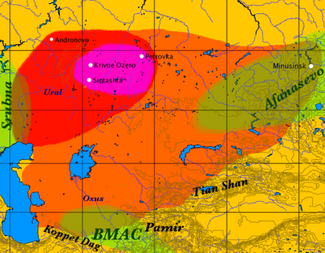
Kazakhstan has been inhabited since the Stone Age, generally by nomads practising pastoralism, for which the region's climate and terrain are best suited. Prehistoric Bronze Age cultures that extended onto Kazakh territory include the Srubna culture (sixteenth-ninth centuries B.C.E.), the Afanasevo culture (3500—2500 B.C.E.) and the Andronovo culture (ca. 2300–1000 B.C.E.).
Historians believe the vast steppes of Kazakhstan were where humans first domesticated the horse. Following the Mongolian invasion in the early thirteenth century C.E., administrative districts were established under the Mongol Empire, which eventually became the territories of the Kazakh Khanate. The major medieval cities of Taraz and Hazrat-e Turkestan were founded along the northern route of the Silk Road during this period.
The Goturks
The earliest documented state in the region was the Turkic Kaganate, or Gokturk state, established by the Ashina clan, in the sixth century C.E. The Qarluqs, a confederation of Turkic tribes, established a state in what is now eastern Kazakhstan in 766.
In the eighth and ninth centuries, Arabs conquered portions of southern Kazakhstan and introduced Islam. The Oghuz Turks controlled western Kazakhstan from the ninth through the eleventh centuries; the Kimak and Kipchak peoples, also of Turkic origin, controlled the east at roughly the same time. The large central desert of Kazakhstan is still called Dashti-Kipchak, or the Kipchak Steppe.
In the late ninth century, invaders destroyed the Qarluq state and established the large Qarakhanid state, which occupied Transoxiana, the area north and east of the Oxus River (the present-day Amu Darya), extending into what is now China. Beginning in the early eleventh century, the Qarakhanids fought among themselves and with the Seljuk Turks to the south.
In the course of these conflicts, parts of present-day Kazakhstan shifted back and forth between the combatants. The Qarakhanids, who accepted Islam and the authority of the Arab Abbasid caliphs of Baghdad, were conquered in the 1130s by the Karakitai, a Turkic confederation from northern China. In the mid-twelfth century, an independent state of Khorazm along the Oxus River broke away from the weakening Karakitai, but the bulk of the Karakitai state lasted until the Mongol invasion of Genghis Khan in 1219-1221.
Mongol invasion
After the Mongol capture of the Karakitai state, Kazakhstan fell under the control of a succession of rulers of the Mongolian Golden Horde, the western branch of the Mongol Empire. The horde, or zhuz, is the precursor of the present-day clan. By the early fifteenth century, the ruling structure had split into several large groups known as khanates, including the Nogai Horde and the Uzbek Khanate.
The Kazakhs emerged from a mixture of tribes living in the region in about the fifteenth century and by the middle of the sixteenth century had developed a common language, culture, and economy. In the early 1600s, the Kazakh Khanate separated into the Great, Middle and Little (or Small) Hordes (jüz) — confederations based on extended family networks. Political disunion, competition among the hordes, and a lack of an internal market weakened the Kazakh Khanate. The beginning of the eighteenth century marked the zenith of the Kazakh Khanate.
Russian rule
In the nineteenth century, the Russian Empire spread into Central Asia. The "Great Game" period of rivalry and strategic conflict between the British Empire and the Tsarist Russian Empire for supremacy in Central Asia, is regarded as running from approximately 1813 to the Anglo-Russian Convention of 1907. Following the Bolshevik Revolution of 1917 a second less intensive phase followed. The tsars effectively ruled over most of the territory belonging to what is now the Republic of Kazakhstan.
The Russian Empire introduced a system of administration and built military garrisons and barracks in its effort to establish a presence in Central Asia. The use of the Russian language was required in all schools and government organizations, arousing resentment among the Kazakh people. By the 1860s, most Kazakhs resisted Russia's annexation because it disrupted the traditional nomadic lifestyle and livestock-based economy. A Kazakh national movement began in the late 1800s, seeking to preserve the Kazakh language and identity. From the 1890s, increasing numbers of Slavic settlers began colonising the area, especially once the Trans-Aral Railway from Orenburg to Tashkent was completed in 1906. The competition for land and water during the final years of tsarist Russia resulted in an uprising, the Central Asian Revolt, in 1916.
Soviet rule
Although there was a brief period of autonomy during the tumultuous period following the collapse of the Russian Empire, the Kazakhs eventually succumbed to Soviet rule. In 1920, the area of present-day Kazakhstan became an autonomous republic within Russia and, in 1936, a Soviet republic.
Soviet repression of the traditional elite, along with forced collectivization in late 1920s–1930s, brought mass hunger and led to unrest. Soviet rule, however, took hold, and a communist apparatus steadily worked to fully integrate Kazakhstan into the Soviet system. Kazakhstan experienced population inflows of thousands exiled from other parts of the Soviet Union during the 1930s and later became home for hundreds of thousands evacuated from the Second World War battlefields. Some of these evacuees were deported to Siberia or Kazakhstan merely due to their ethnic heritage or beliefs, and were in many cases interned in some of the biggest Soviet labor camps. The Kazakh Soviet Socialist Republic (SSR) contributed five national divisions to the Soviet Union's World War II effort. In 1947, two years after the end of the war, the Semipalatinsk Test Site, the USSR's main nuclear weapon test site was founded near the city of Semey.
The period of World War II marked an increase in industrialization and increased mineral extraction in support of the war effort. At the time of Soviet leader Joseph Stalin's death, however, Kazakhstan still had an overwhelmingly agricultural-based economy. In 1953, Soviet leader Nikita Khrushchev initiated the ambitious "Virgin Lands" program to turn the traditional pasturelands of Kazakhstan into a major grain-producing region for the Soviet Union. The Virgin Lands policy, along with later modernizations under Soviet leader Leonid Brezhnev, sped up the development of the agricultural sector, which to this day remains the source of livelihood for a large percentage of Kazakhstan's population.
Growing tensions within Soviet society led to a demand for political and economic reforms, which came to a head in the 1980s. In December 1986, mass demonstrations by young ethnic Kazakhs took place in Almaty to protest the replacement of the First Secretary of the Communist Party of Kazakhstan Dinmukhamed Konayev with Gennady Kolbin, an ethnic Chuvas from Russian Federation. Soviet troops suppressed the unrest, and dozens of demonstrators were jailed or killed. In the waning days of Soviet rule, discontent continued to grow and find expression under Soviet leader Mikhail Gorbachev's policy of glasnost. Caught up in the groundswell of Soviet republics seeking greater autonomy, Kazakhstan declared its sovereignty as a republic within the Union of Soviet Socialist Republics in October 1990. Following the August 1991 abortive coup attempt in Moscow and the subsequent dissolution of the Soviet Union, Kazakhstan declared independence on December 16, 1991.
Independence
The years following independence have been marked by significant reforms to the Soviet command-economy and political monopoly on power. Under Nursultan Nazarbayev, who initially came to power in 1989 as the head of the Communist Party of Kazakhstan, and was eventually elected president in 1991, Kazakhstan has made significant progress toward developing market economy. The country has enjoyed significant economic growth since 2000, partly due to its large oil, gas, and mineral reserves.
Politics
The politics of Kazakhstan take place in the framework of a presidential republic, whereby the President of Kazakhstan is head of state and nominates the head of government. The nature of government is authoritarian presidential rule, with little power outside the executive branch.
The president is elected by popular vote for a seven-year term, and constitutionally had a two-term limit. An election was last held in December 2005. The president appoints a council of ministers (cabinet). The president also is the commander in chief of the armed forces and may veto legislation that has been passed by the Parliament.
The president, Nursultan Nazarbayev, who was the top Communist leader of the of the Kazakh Soviet Socialist Republic when the Soviet Union disbanded in 1991, was easily elected president in November, 1991. He arranged a referendum in 1995 that extended his term of office and expanded his presidential powers. Only he can initiate constitutional amendments, appoint and dismiss the government, dissolve parliament, call referenda at his discretion, and appoint administrative heads of regions and cities.
The president appoints the prime minister and first deputy prime minister. The prime minister chairs the Cabinet of Ministers and serves as Kazakhstan's head of government. There are three deputy prime ministers and 16 ministers in the Cabinet. Daniyal K. Akhmetov became the Prime Minister in June 2003 but resigned 8 January, 2007. The president appoints a Council of Ministers.
The bicameral parliament comprises a Senate and a Mazhilis. The Senate, has 39 seats. Seven senators are appointed by the president. Other members are elected by local government bodies — two from each of the 14 oblasts, the capital of Astana, and the city of Almaty, to serve six-year terms. In addition, ex-presidents are ex-officio senators for life. The Mazhilis has 77 seats. Ten out of the 77 Mazhilis members are elected from the winning party's lists. Other members are popularly elected to serve five-year terms. Majilis deputies and the government both have the right of legislative initiative, though most legislation considered by the Parliament is proposed by the government. All aged 18 years of age and over may vote.
The judiciary comprises a Supreme Court of 44 members and a Constitutional Council of seven members. Local and national courts resemble those in the Western world, but lack of checks and controls. A variety of different police units, a remnant of the Soviet era, leads to problems of jurisdiction. In urban areas, robberies and theft are common. Murder, suicide, and other violent crimes are increasing. The drug trade from Afghanistan has given rise to organized crime. Embezzlement, tax fraud, and abuse of power and privilege are tacitly accepted.
Elections
Elections to the Majilis in September 2004 yielded a lower house dominated by the pro-government Otan party, headed by President Nazarbayev. Two other parties considered sympathetic to the president, including the agrarian-industrial bloc AIST and the Asar party, founded by President Nazarbayev’s daughter, won most of the remaining seats. Opposition parties, which were officially registered and competed in the elections, won a single seat during elections that the Organization for Security and Cooperation in Europe said fell short of international standards.
In 1999, Kazakhstan applied for observer status at the Council of Europe Parliamentary Assembly. The official response of the assembly was that Kazakhstan could apply for full membership, because it is partially located in Europe, but that they would not be granted any status whatsoever at the Council until their democracy and human rights records improved.
President Nazarbayev, who has been in office since Kazakhstan became independent, won landslide victories in the 1999 and 2005 elections that the Organization for Security and Cooperation in Europe said fell short of international standards.
Kazakhstan's National Security Committee was established in 1992. It includes the Service of Internal Security, Military Counterintelligence, Border Guard, several Commando units, and Foreign Intelligence (Barlau). The latter is considered by many as the most important part of the committee.
In June 1992, the Soviet Armed Forces Turkestan Military District disbanded, following the collapse of the Soviet Union. The most powerful grouping went to become the core of Kazakhstan's new military which acquired all the units of the 40th (the former 32nd) Army and part of the 17th Army Corps, including six land force divisions, storage bases, the 14th and 35th air-landing brigades, two rocket brigades, two artillery regiments and a large amount of equipment which had been withdrawn from over the Urals after the signing of the Treaty on Conventional Armed Forces in Europe.
The Kazakh Air Defence Force's fighter aircraft element consists of the 356th Fighter Aviation Regiment, flying MiG-31s from Semipalitinsk Airport. The Republican Guard had 2500 soldiers in 1994, and is not part of the army.
Kazakhstan also sent 29 military engineers under Polish command in Iraq as part of the Coalition of the Willing to assist the US occupation in Iraq in order save money for its small economy while giving small support to the west.
Administrative divisions
Kazakhstan is divided into 14 provinces (oblys) and three municipal districts (qala). Each is headed by an Akim (provincial governor) appointed by the president. Municipal Akims are appointed by oblast Akims. The Government of Kazakhstan transferred its capital from Almaty to Astana on December 10, 1997.
In 1995 the Governments of Kazakhstan and Russia entered into an agreement whereby Russia would lease for a period of 20 years an area of 2300 square miles (6000 square kilometres) enclosing the Baikonur Cosmodrome space launch facilities and the city of Bayqongyr (formerly Leninsk). The lease was later extended through 2050. On June 18, 2006, Kazakhstan became a space-faring nation in its own right when it launched its first commercial satellite, KazSat 1, from the Baikonur Cosmodrome on a Russian-built booster rocket.
Foreign relations
Kazakhstan has stable relationships with all of its neighbors and is a member of the United Nations, Organization for Security and Cooperation in Europe, Euro-Atlantic Partnership Council and Organization of the Islamic Conference(OIC). It is an active participant in the North Atlantic Treaty Organisation's (NATO) Partnership for Peace program. Kazakhstan is also a member of the Commonwealth of Independent States, the Economic Cooperation Organization (ECO) and the Shanghai Cooperation Organization along with Russia, China, Kyrgyzstan, Tajikistan, and Uzbekistan. The nations of Kazakhstan, Belarus, Kyrgyzstan, and Tajikistan established the Eurasian Economic Community in 2000 to re-energize earlier efforts at harmonizing trade tariffs and the creation of a free trade zone under a customs union.
Since independence in 1991, Kazakhstan has pursued what is known as the multi-dimensional foreign policy, seeking equally good relations with two large neighbors, Russia and China, and the United States and the West generally. The policy has yielded results in the oil and gas sector, where companies from the U.S., Russia, China, and Europe are present at all major fields, and in the multidimensional directions of oil export pipelines out of Kazakhstan.
Economy
Kazakhstan, the largest of the former Soviet republics in territory, excluding Russia, possesses enormous fossil fuel reserves and plentiful supplies of other minerals and metals. It also has a large agricultural sector featuring livestock and grain. Kazakhstan's industrial sector rests on the extraction and processing of these natural resources and also on a growing machine-building sector specializing in construction equipment, tractors, agricultural machinery, and some defense items.
The breakup of the USSR in December 1991 and the collapse in demand for Kazakhstan's traditional heavy industry products resulted in a short-term contraction of the economy, with the steepest annual decline occurring in 1994. In 1995-97, the pace of the government program of economic reform and privatization quickened, resulting in a substantial shifting of assets into the private sector.
Kazakhstan enjoyed double-digit growth in 2000-01 – eight percent or more per year in 2002-06 - thanks largely to its booming energy sector, but also to economic reform, good harvests, and foreign investment. The opening of the Caspian Consortium pipeline in 2001, from western Kazakhstan's Tengiz oilfield to the Black Sea, substantially raised export capacity. Kazakhstan in 2006 completed the Atasu-Alashankou portion of an oil pipeline to China that is planned to extend from the country's Caspian coast eastward to the Chinese border in future construction.
The country has embarked upon an industrial policy designed to diversify the economy away from over-dependence on the oil sector by developing light industry. The policy aims to reduce the influence of foreign investment and foreign personnel. The government has engaged in several disputes with foreign oil companies over the terms of production agreements; tensions continue. Upward pressure on the local currency continued in 2006 due to massive oil-related foreign-exchange inflows. Aided by strong growth and low inflation, Kazakhstan aspires to become a regional financial center and has created a banking system comparable to those in Central Europe.
In 2000, Kazakhstan adopted a new tax code in an effort to consolidate gains. In November 2003 the new tax code was adopted, reducing value added tax from 16 percent to 15 percent, the social tax from 21 percent to 20 percent, and the personal income tax from 30 percent to 20 percent.
Oil and gas
Energy is the leading economic sector. Production of crude oil and natural gas condensate in Kazakhstan amounted to 51.2 million tons in 2003. Kazakhstan's 2003 oil exports were valued at more than $7-billion, representing 65 percent of overall exports and 24 percent of the GDP. Major oil and gas fields and their recoverable oil reserves are Tengiz with seven billion barrels; Karachaganak with eight billion barrels (and 1350km³ of natural gas); and Kashagan with seven to nine billion barrels.
Agriculture
Agriculture accounted for 13.6 percent of Kazakhstan's GDP in 2003. Grain (Kazakhstan is the sixth-largest producer in the world) and livestock are the most important agricultural commodities. Agricultural land occupies more than 327,000 square miles (846,000 square kilometres). Chief livestock products are dairy products, leather, meat, and wool. The country's major crops include wheat, barley, cotton, and rice. Wheat exports, a major source of hard currency, rank among the leading commodities in Kazakhstan's export trade. In 2003 Kazakhstan harvested 17.6 million tons of grain in gross, 2.8 percent higher compared to 2002. Kazakh agriculture still has many environmental problems from mismanagement during its years in the Soviet Union.

Exports totalled $35.55-billion in 2006. Export commodities included oil and oil products 58 percent, ferrous metals 24 percent, chemicals 5 percent, machinery 3 percent, grain, wool, meat, and coal. Export partners included Russia 12.4 percent, Germany 12 percent, China 11.2 percent, Italy 8.9 percent, France 8.6 percent, Romania 5.1 percent, US 4.5 percent.
Imports totalled $22-billion in 2006. Import commodities included machinery and equipment 41 percent, metal products 28 percent, foodstuffs 8 percent. Import partners included Russia 35.7 percent, China 21.3 percent, and Germany 7.1 percent.
Per capita GDP was $8318 in 2005, and per capita rank was 70th on a list of 194 countries.
Demographics
Kazakhstan has a diverse demography is due to the country's central location and its use by Russia as a place to send colonists, dissidents, and minority groups. One can almost not understand Kazakhstan without understanding population transfer in the Soviet Union. From the 1930s until the 1950s, many minorities had been interned in labor camps often merely due to their heritage or beliefs, mostly on collective orders by Stalin. This makes Kazakhstan one of the few places on earth where normally-disparate Germanic, Indo-Iranian, Chinese, Chechen, and Turkic groups live together in a rural setting and not as a result of modern immigration.
Population
As of 2003, there is a discrepancy between reputable sources as to the population of Kazakhstan. United States government sources including the CIA World Fact Book and the US Census Bureau International Data Base list the population as 16,763,795, while United Nations sources such as the World Bank give a 2002 estimate of 14,794,830. This rather large discrepancy is presumably due to difficulties in measurement caused by the large migratory population of Kazakhstan, emigration, and the low population density - only about 5.5 persons per km² in an area the size of Western Europe.
After the fall of the Soviet Union, the German population of Kazakhstan proceeded to emigrate en masse during the 1990s, as Germany was willing to repatriate them. Also much of the smaller Greek minority took the chance to repatriate to Greece, so did many Russians move to Russia. Some groups have fewer good options for emigration but because of the economic situation are also leaving at rates comparable to the rest of the former East bloc.
This was a key factor in giving the autochthonous Kazakhs a majority along with higher Kazakh birthrates and ethnic Kazakh immigration from the People's Republic of China, Mongolia, and Russia. In the early twenty first century, Kazakhstan has become one of the leading nations in international adoptions.
Ethnicity
According to the 1999 census there are two dominant ethnical groups in Kazakhstan. They are ethnic Kazakhs (53.4 percent) and ethnic Russians (30 percent) with an amazingly rich array of other groups represented, including Ukrainians, Uzbeks, Germans, Chechens, Koreans, and Uyghurs - that is, virtually any group that has ever come under the Russian sphere of influence. There is also a small but active Jewish community.
The Russian term “Kazakhstani” was coined to describe all inhabitants of Kazakhstan, including non-Kazakhs. The word "Kazakh" is generally used to refer to people of actual Kazakh descent (including those living in China, Afghanistan, and other Central Asian countries).
Religion
Arabs brought Islam in the ninth century, and 1000 years later Russian settlers introduced Russian Orthodoxy. Religious participation was banned, and many churches and mosques were destroyed during the 70 years of Soviet rule. In 2007, the main religious groups were Muslim (mainly Sunni) 47 percent, Russian Orthodox 44 percent, Protestant 2 percent, and other 7 percent.
Although Islam was introduced in the ninth century, the religion was not fully assimilated until much later. As a result, it coexisted with earlier elements of Tengriism. Traditional Kazak belief held that separate spirits inhabited and animated the earth, sky, water, and fire, as well as domestic animals. To this day, particularly honored guests in rural settings are treated to a feast of freshly killed lamb. Such guests are sometimes asked to bless the lamb and to ask its spirit for permission to partake of its flesh.
While formal religious observance is limited, many Kazakhs say a short prayer when they pass by where someone they know is buried, and often say prayers after meals. Mosques are staffed by a mullah, who conducts services as well as funerals, weddings, and blessings, as do priests in Russian Orthodox churches.
Language
Kazakhstan is a bilingual country. The Kazakh language, a Turkic language, is spoken by 64.4 percent of the population, and has the status of the "state" language, while Russian is declared the "official" language, and is used routinely in business. Language is a contentious issue. While Russian has been so widely used as the interethnic means of communications, Kazakhstan has not been able to use its distinct national language to unite ethnic communities.
Men and women
Women occupy important roles in the workforce as school principals, bank presidents, teachers, accountants, police officers, secretaries, and government workers, and make up half of the workforce. This trend was expected to continue as girls out-performed boys at school and alcoholism among men increased. Kazakh culture is traditionally patriarchal. In rural areas women prepare the food, and do interior household chores.
Kazakh men shake hands with an acquaintance the first time they see each other in a day. All remove their shoes when inside a house — guests remove their shoes at the door and often put on a pair of slippers. Greetings are structured.
Marriage and the family
Marriages are usually formed through dating and courtship. Interracial marriage is rare. No couple related over the past seven generations may marry, and the male should be older than the female. Families of the bride and groom meet before the wedding, and exchange gifts and dowries. Weddings are three-day events. Divorce is not uncommon, there are no rules for who gets what, but women usually keep the children.
A nomadic tradition of wife stealing is still practiced, although rarely. A man may kidnap any unmarried girl 15 years of age and over. The girl spends a night alone with the man. The next day she is taken to meet her mother-in-law, who ties a scarf around the girl's head show she is married.
Domestic units are rarely just a mother, father, and their children, since grandparents and extended family often live within one household. The youngest son may take a wife and have a family, but is expected to stay at home with his parents and care for them into their old age. Kazakhs regard it as important to know about their kin groups. Relatives from far away can be expected to help financially in times of crisis.
At childbirth, some Kazakhs practice a custom of not letting anyone besides close family members see a newborn for the first 40 days of life. Then the family holds a small party and presents the baby to extended family and friends. Babies are well cared for and cherished. Children go to kindergarten at ages four or five, and first grade and formal schooling start at age six.
Education
Education is universal and mandatory through to the secondary level. There are three main educational phases: Primary education (forms 1 to 4), basic general education (forms 5–9) and senior level education (forms 10–11 or 12) divided into continued general education and professional education. Primary education is preceded by one year of pre-school education. These three levels of education can be followed in one institution or in different ones (e.g. primary school, then secondary school).
New entrants are assigned to classes of about 25 pupils in the first grade, and that class stays together until the 11th grade, with the same teacher until the fourth grade, and a different teacher through to the eleventh grade. The teachers are like second mothers or fathers, discipline is important, homework is extensive and grades difficult.
Several secondary schools, specialized schools, magnet schools, gymnasium schools, lyceums, linguistic and technical gymnasiums, have been founded. Secondary professional education is offered in special professional or technical schools, lyceums or colleges and vocational schools.
At tertiary level, there are universities, academies, and institutes, conservatories, higher schools and higher colleges. At this level, there are three main levels: basic higher education that provides the fundamentals of the chosen field of study and leads to a bachelor degree; specialized higher education after which students are awarded the specialist's diploma; and scientific-pedagogical higher education which leads to the master's degree.
Postgraduate education leads to the Kandidat Nauk (Candidate of Sciences) and the Doctor of Sciences. With the adoption of the Laws on Education and on Higher Education, a private sector has been established and several private institutions have been licensed. The adult literacy rate is 99.5 percent.
In 2000, the Government of Kazakhstan joined the governments of the Kyrgyzstan and Tajikistan, and Aga Khan IV to establish the world’s first internationally chartered institution of higher education, the University of Central Asia, which was intended to have three campuses of equal size and stature in each of the founding countries.
Ownership
Houses built and subsidized by the former Soviet government were cheap and available to all, and most people retained their property from the Soviet years. Occupiers own most apartments, although the practice of developing an area and renting out dwellings and shops is becoming more widespread.
Class
The new rich, who often flaunt their wealth, are termed "New Kazakh" or "New Russian," and contrast with the vast number of unemployed or underpaid. Poverty and accusations of unfair treatment have raised tensions between Kazakhs and non-Kazakhs. While the rich drive expensive cars, wear fashionable clothes, and throw lavish parties, the poor drive old Soviet cars or take a bus, wear cheap Chinese- or Turkish-import clothes, and save for months to pay for a wedding.
Culture
Before the Russian conquest, the Kazaks had a well-articulated culture based on their nomadic pastoral economy. Besides lamb, many other traditional foods retain symbolic value in Kazak culture.
Because animal husbandry was central to the Kazaks' traditional lifestyle, most of their nomadic practices and customs relate in some way to livestock. Traditional curses and blessings invoked disease or fecundity among animals, and good manners required that a person ask first about the health of a man's livestock when greeting him and only afterward inquire about the human aspects of his life.
Kazakhs can be superstitious. Whistling inside a house is unacceptable since it is believed that it will make the owner of the house poor. Smoking by women is not accepted. Kazakhs often don't smile at people in public except to those they know, and rarely form lines when boarding crowded buses. Women and girls often hold hands as they walk; boys hook arms or walk with their arms around each other. Kissing cheeks and embracing is perfectly acceptable between good friends.
Architecture
The traditional Kazak dwelling is the yurt, a tent consisting of a flexible framework of willow wood covered with varying thicknesses of felt. The open top permits smoke from the central hearth to escape; temperature and draft can be controlled by a flap that increases or decreases the size of the opening. A properly constructed yurt can be cooled in summer and warmed in winter, and it can be disassembled or set up in less than an hour. The interior of the yurt has ritual significance; the right side generally is reserved for men and the left for women.
Although yurts are less used for their original purpose than they once were, they remain a potent symbol. During political demonstrations in the spring of 1992, demonstrators and hunger strikers erected yurts in front of the government building in Almaty. Yurts are also frequently used as a decorative motif in restaurants and other public buildings.
Russian settlers in the eighteenth and nineteenth centuries brought small A-frame houses, Russian orthodox churches, and wooden buildings.
Buildings from the Soviet era were big and utilitarian, and often the same shape, size, and color throughout the Soviet empire. Large Soviet-designed apartment blocks were five or six stories high and had three to four apartments of one, two, or three bedrooms each per floor. Villages and collectives consisted of small two- to three-room, one-story houses, painted white and light blue (to keep away evil spirits), all built by the government. Large squares and parks were built in every town.
Oil money, and foreign investment have brought five-star high-rise hotels, casinos, Turkish fast food restaurants, American steak houses, bowling alleys and movie theaters. Private homes are bigger, with two- and three-stories, two-car garages and large, fenced-in yards.
Cuisine

Daily meals are hearty, always including bread and usually noodles or potatoes and then a meat. One common dish is pilaf, a rice dish usually made with carrots, mutton, and a lot of oil. Russian borscht, usually red (beet-based) or brown (meat-based), with cabbage, meat, and potatoes, and a large dollop of sour cream, is popular. Russian pelimnin, dough pockets filled with meat and onions, is often a daily meal.
A flat, round bread called leipioskka) and seasonal fruits and vegetables are served with almost every meal. Kazakhstan is known for its apples. Shashlik, marinated meat roasted over a small flame and served on a stick, is sold at roadside cafés and corner shashlik stands.
Tea is an integral part of life, and is drunk six or seven times a day. Guests are always offered tea. Muslim Kazakhs do not eat pork, and have great respect for bread, which should never be wasted, thrown away, and should always be placed on the table right side up. Food is eaten with one's hands.
On special occasions, beshbarmak, traditionally horse meat boiled on the bone, is served over noodles covered in a meat broth called souppa. The host gives out pieces of meat in an order of respect usually based on seniority or distance traveled. When beshbarmak is made of sheep, the head of the sheep will be boiled, intact, and served to the most honored guest. An intoxicating fermented horse's milk called kumis, believed to be therapeutic, is occasionally drunk at ceremonial occasions. Vodka, which permeates the culture, is consumed in large quantities at all ceremonies. Toasts always precede a drink of vodka.
Music
Kazakh music is nomadic and rural, and is closely related to Uzbek and Kyrgyz folk forms. Travelling bards, healers and mystics called akyn are popular, and usually sing either unaccompanied or with a string instrument, especially a dombra or kobyz. Akyn performance contests are called aitys; their lyrics are often social or political, and are generally improvised, witty remarks.
Traditional Kazakh music includes ensembles using instruments like the kobyz (qobuz) or dombra, as well as kyl-kobyz, sherter, sybyzgy, saszyrnay and shankobyz; the most common instrumental traditions are called kobizovaia, sibiz-govaia, and dombrovaia. Many songs are connected to ancient mythology and folk religious beliefs (kui), while others were composed after the rise of authored works (kuishi) by early songwriters (jiray) like Mahmud Kashgari, Kaztygana, Dospanbeta, Shalkiiza and Aktamberdi. The kuishi tradition is said to have peaked in the ninetenth century, when composers like Kurmangazy, Madi Baliuly and Birjan and singers like Ahan were active. In the twentieth century, the first major star was the singer Mayra Shamsutdinova, who was, unusual for the time, a woman.
Controlled by the Russian Empire and then the Soviet Union, Kazakhstan's folk and classical traditions became connected with ethnic Russian music and Western European music. The Musical-Dramatic Training College]], founded in 1932, was the first institute of higher education for music. Two years later, the Orchestra of Kazak Folk Musical Instruments was formed
The Kazakhs themselves, however, did not write their own music in notation until 1931. Later, as part of the Soviet Union, Kazakh folk culture was encouraged in a sanitized manner designed to avoid political and social unrest. The result was a bland derivative of real Kazakh folk music. In 1920, A. V. Zataevich, a Russian official who created works of art music with melodies and other elements of Kazakh folk music, adapted traditional Kazakh instruments for use in Russian-style ensembles, such as by increasing the number of frets and strings.
Pop music in Kazakhstan has made a resurgence since the year 2000. Talent searches have always been an integral part of the Kazakh pop music industry, such as the project Anshi Balapan & Idol spinoff SuperStar KZ, a reality television show based on the popular British show Pop Idol. The show is a contest to determine the best young singer in Kazakhstan.
Literature
Kazak literary tradition is rich in oral histories. These histories were memorized and recited by the akyn, the elder responsible for remembering the legends and histories, and by jyrau, lyric poets who traveled with the high-placed khans. Most of the legends concern the activities of a batir, or hero-warrior.
Among the tales that have survived are Koblandy-batir (fifteenth or sixteenth century), Er Sain (sixteenth century), and Er Targyn (sixteenth century), all of which concern the struggle against the Kalmyks; Kozy Korpesh and Bain sulu, both epics; and the love lyric Kyz-Zhibek. Usually these tales were recited in a song-like chant, frequently to the accompaniment of such traditional instruments as drums and the dombra, a mandolin-like string instrument.
For the most part, pre-independence cultural life in Kazakstan was indistinguishable from that elsewhere in the Soviet Union. That Russified cultural establishment nevertheless produced many of the most important figures of the early stages of Kazak nationalist self-assertion, including novelist Anuar Alimzhanov, who became president of the last Soviet Congress of People's Deputies, and poets Mukhtar Shakhanov and Olzhas Suleymenov, who were co-presidents of the political party Popular Congress of Kazakstan.
Suleymenov in 1975 became a pan-Central Asian hero by publishing a book, Az i Ia, examining the Lay of Igor's Campaign, a medieval tale vital to the Russian national culture, from the perspective of the Turkic Pechenegs whom Igor defeated. Soviet authorities subjected the book to a blistering attack. Later Suleymenov used his prestige to give authority to the Nevada-Semipalatinsk anti-nuclear movement, which helped end nuclear testing in Kazakstan.
Movies
In September 2006 the government announced that it is funding distribution of a multi million dollar movie called "Nomad" a Kazakhstan government version of the history of the nation. The movie started in 2003, and has been plagued with multiple development problems, though it is now 'on track' for a North American release in 2006-2007. News agencies reported the Kazakhstan government was sponsoring this movie as an effort to combat negative international publicity, including the comedy character Borat.
Sports
Kazakhstan has achieved some success in international competitions in weightlifting, ice hockey, and boxing. Kazakhstan won eight medals in the 2004 Summer Olympics - the largest tally for any nation in Western Asia. Football (soccer) is popular, with the Kazakhstan Super League being the top-level competition for the sport in the country.
Numerous professional cyclists competing on the European circuit come from Kazakhstan. Most notable is Alexander Vinokourov.
Aliya Yussupova placed 4th in Summer Olympic Games in Athens. She has been among medal winners in several previous tournaments. Currently, she is considered to be one of the top rhythmic gymnasts in the world.
Kazakh boxers in the last three Olympic had more medals than any countries except Cuba and Russia. In 1996 and 2004 two Kazakh boxers (Vasiliy Jirov in 1996 and Bakhtiyar Artayev in 2004) were recognized as the best boxers for their techniques with the Val Barker trophy, awarded to the best boxer of the tournament. Kazakhstani boxer Oleg Maskaev was the WBC Heavyweight Champion after knocking out Hasim Rahman on August 12, 2006.
The Kazakhstani national ice hockey team has competed in ice hockey in the 1998 and 2006 Winter Olympics as well as in the 2006 Men's World Ice Hockey Championships.
Public holidays
Public holidays include: January 1, New Year's Day; January 7, Russian Orthodox Christmas (not an official holiday, but usually taken as a vacation);. March 8, International Women's Day; March 22, Nauryz Meyrami (a springtime holiday marking the begining of a new year); May 1, Kazakhstan People’s May Day; May 9, World War II Victory Day; August 30, Constitution Day; October 25,Republic Day; December 16, Independence Day.
ReferencesISBN links support NWE through referral fees
- Broughton, Simon and Sultanova, Razia. "Bards of the Golden Road". 2000. In Broughton, Simon and Ellingham, Mark with McConnachie, James and Duane, Orla (Ed.), World Music, Vol. 2: Latin & North America, Caribbean, India, Asia and Pacific, pp 24-31. Rough Guides Ltd, Penguin Books. ISBN 1-85828-636-0
- Cummings, Sally N. 2005. Kazakhstan power and the elite. London: I.B. Tauris. ISBN 142372903X
- Demko, George J. 1969. The Russian colonization of Kazakhstan, 1896-1916. Indiana University publications. The Hague [etc.]: Mouton. OCLC 63360103
- Fergus, Michael, and Janar Jandosova. 2003. Kazakhstan: coming of age. London: Stacey International. ISBN 1900988615
- George, Alexandra. 2001. Journey into Kazakhstan: the true face of the Nazarbayev regime. Lanham: University Press of America. ISBN 0761819649
- Martin, Virginia. 2000. Law and custom in the steppe: the Kazakhs of the Middle Horde and Russian colonialism in the nineteenth century. Richmond: Curzon. ISBN 0700714057
- Nazarbaev, Nursultan. 2001. Epicenter of peace. Hollis, NH: Puritan Press. ISBN 1884186130
- Nazpary, Joma. 2002. Post-soviet chaos: violence and dispossession in Kazakhstan. London: Pluto Press. ISBN 0745315038
- Olcott, Martha Brill. 1987. The Kazakhs. Studies of nationalities in the USSR. Stanford, Calif: Hoover Institution Press, Stanford University. ISBN 0817983821
- Olcott, Martha Brill. 2002. Kazakhstan: unfulfilled promise. Washington, D.C.: Carnegie Endowment for International Peace. ISBN 0870031899
- Rall, Ted. 2006. Silk road to ruin: is Central Asia the new Middle East? New York: NBM. ISBN 1561634549
- Rosten, Keith. 2005. Once in Kazakhstan: the snow leopard emerges. New York: iUniverse. ISBN 0595327826
External links
- Kazakhstan Countries and Their Cultures, accessed April 12, 2007.
- Background Note: Kazakhstan U.S. Department of State, accessed April 13, 2007.
- Country Study: Kazakhstan U.S. Library of Congress, accessed April 13, 2007.
- KazakhstanWorld Factbook 2007, accessed April 13, 2007.
- Embassy of Kazakhstan to the USA and Canada Accessed April 13, 2007.
- Government of Kazakhstan Accessed April 13, 2007.
- President of the Republic of Kazakhstan Accessed April 13, 2007.
- National Bank of Kazakhstan Accessed April 13, 2007.
- Kazakhstan BBC News Country Profiles, accessed April 13, 2007.
- Kazakhstan Open Directory Project, accessed April 13, 2007.
- Kazakhstan The World Bank, accessed April 13, 2007.
- Kazakhstan UN Office for the Coordination of Humanitarian Affairs, accessed April 13, 2007.
- The Kazakhstan Post Accessed April 13, 2007.
Credits
New World Encyclopedia writers and editors rewrote and completed the Wikipedia article in accordance with New World Encyclopedia standards. This article abides by terms of the Creative Commons CC-by-sa 3.0 License (CC-by-sa), which may be used and disseminated with proper attribution. Credit is due under the terms of this license that can reference both the New World Encyclopedia contributors and the selfless volunteer contributors of the Wikimedia Foundation. To cite this article click here for a list of acceptable citing formats.The history of earlier contributions by wikipedians is accessible to researchers here:
The history of this article since it was imported to New World Encyclopedia:
Note: Some restrictions may apply to use of individual images which are separately licensed.

